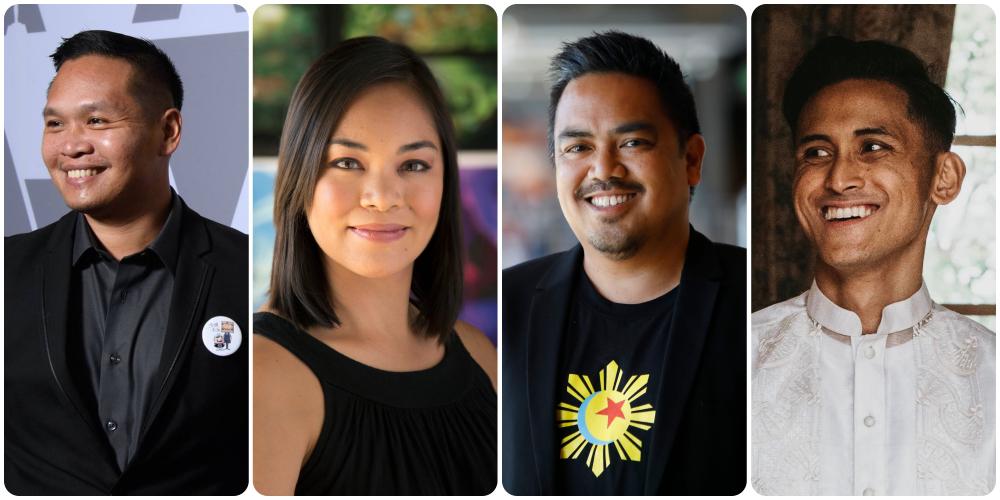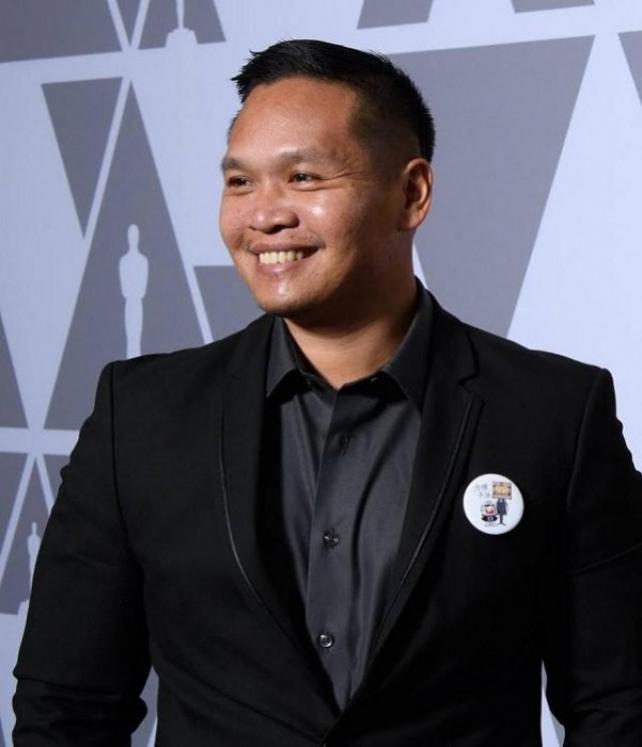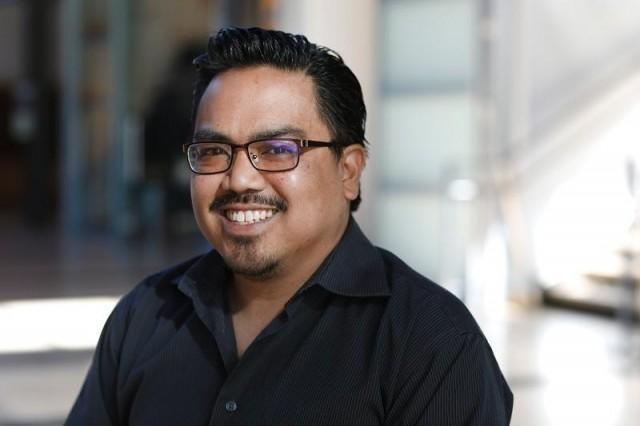Fil-Am directors of animation want to reach out to Pinoy animators

Los Angeles — A group of Filipino-American directors of animation have come together to help, inspire, and reach out to BIPOC (Black, Indigenous, People of Color) animators who want to build a career in animation or to simply improve their craft.
They have been creating panels, showcasing top Filipino-American directors of animation, and allowing anybody who is interested to listen and ask questions, whether they are in the industry of animation or not, simply curious, or interested to have an animation career.
Bobby Pontillas, a Fil-Am Oscar nominee and show creator at Disney, reached out to us to let us know that such an event is happening on Thursday, August 6, via Instagram (@riseupanimation) at 6:00 pm (PST) or 9:00 am (PH).
Thursday's panel includes Josie Trinidad, director at Disney Animation who was behind such movies as “Zootopia” and “Ralph Breaks the Internet”, Bobby Rubio, director at Pixar Animation, who created the short “Float,” the first Pixar film to showcase a Filipino character, and Ian Abando, director at Netflix Animation who was behind the “Spider-Man” TV series.
We interviewed Pontillas and the featured panelists via email and below are their responses:
BOBBY PONTILLAS, SHOW CREATOR (DISNEY)

Talk about the genesis of Rise Up Animation panel, featuring Filipino directors in animation. Is this only on Instagram? How did you get involved in this?
Rise Up Animation has been broadcasting virtual panels spotlighting BIPOC voices in animation to champion diversity and inclusivity. I naturally wanted to organize a panel featuring Filipino directors because I wanted to spotlight Filipino creative voices in animation.
I wanted to represent for Filipinos everywhere and show them that they could thrive in this industry! The panel is taking place over a Zoom Webinar, and later will be posted to our Instagram page and our Rise Up YouTube channel.
Can you name some of the Filipino directors who have participated already? Who chooses the panel participants? Is this open to anyone or just specifically to Filipino animators in the Philippines and the U.S.?
We’ve hosted Paul Abadilla (Art Director at Pixar), Nate Villanueva (Director at Lucasfilm), and Erin Ramos (Effects Artist at Disney Animation).
Moderating Thursday’s panel will be myself and John Aquino, director of the short film "Lighting in a Bottle," which is now on Disney+.
It’s always so easy to choose the panel participants because there’s so much humble talent in this industry who are more than willing to help inspire young artists.
This panel is open to everyone, everywhere. We’re looking forward to sharing our stories with the world!
What topics are the panelists going to talk about? Will there be a Q&A after each talk? How long is every panelist talking?
All of the panelists will be talking about their journeys into animation, bringing their life experiences as Filipinos into their animation work, the challenges they’ve faced, and will be giving advice to up and coming artists that would like to also get into animation. There will be a live Q&A at the end. We’re hoping to keep the whole panel from an hour to an hour-and-a-half.
What has been the feedback so far? How do you see this event inspiring and encouraging the aspiring animators in the Philippines or in the U.S.?
We want up and coming Filipino artists to feel seen. If they can see and interface with people who look like them and who have shared their experiences, perhaps it could instill in them the notion that they can succeed in the animation industry as well.
What other programs or events are lined up to help or inspire animators?
Rise Up Animation will be a part of a few events including the virtual Icon Manila event organized annually by the wonderful Armand and Bing Serrano.
Other than that, we are committed to offering all BIPOC free portfolio reviews, feedback, and advice in the hopes of helping them break into the animation industry, thereby helping the industry to be more diverse and inclusive.
As a Fil-Am animator, what was the most challenging thing for you starting in mainstream animation?
The most challenging thing for me was just trying to find the resources and information out there to help me get my foot in the door. I’m from Seattle and Hollywood just seemed so far away.
I can only imagine for young artists from the furthest corners of the world that’s intensified 1000%. Rise Up Animation aims to connect animation industry professionals with everyone around the world.
It’s not until very recently have I committed my creative endeavors to telling more Filipino stories in mainstream animation, so my most challenging times weren’t in the beginning, they’re now! I will die trying.
You created the films “One Small Step” (2018), “Spies in Disguise” (2019) and “Big Hero” (2014). How were those experiences for you and what are your future projects?
I am currently at Disney Television Animation in development. What that means for me day to day is creating early Visual Development art for projects in development, in addition to creating my own project. It’s an exciting time!
What would be your main advice to aspiring animators who also want to make it in Hollywood?
My advice would be: Soak up as much information as you can. Advice for breaking into the animation industry is all out there now - between online panels, videos, and artists’ websites.
Actively seek out what you’re passionate about. Have a target to aim for and work towards that goal with the passion of a thousand suns. It might take some searching but once you find it, practice that skill, put in those hours, all the time, become obsessed with it and go after it with every fiber of your being!
JOSIE TRINIDAD, DIRECTOR, DISNEY ANIMATION
_2018_11_14_18_06_45.JPG)
How did you get involved in this Rise Up Animation panel?
About a month ago, Bobby Pontillas reached out to me to be on a Rise Up Animation panel with fellow Filipino story artists, Ian Abando and Bobby Rubio.
I'd signed up to be a mentor for Rise Up, and since Pontillas is a friend I met a few years ago when he was an animator and character designer on Wreck-It Ralph, I happily agreed to participate in this panel.
I'd met Abando before but not Rubio, yet the animation community is small and we're all pretty aware of other Filipino artists in the industry especially those in story.
What topics are the panelists going to talk about? What is your topic?
The initiative of Rise Up is built around helping people get their foot in the door, so focusing the conversation around our own journeys might be insightful for them. I believe there will be a Q&A, but Pontillas is moderating and will know for certain. I think the panel is about an hour.
What has been the feedback so far? How do you see this event inspiring and encouraging the aspiring animators in the Philippines or in the U.S.?
Response to Rise Up Animation has been tremendous. We're in the middle of "Disney Week" at Rise Up Animation, and there are guest speakers from Walt Disney Animation Studios, Pixar, ILM, and Marvel participating in panels that average over 2000 viewers each. Volunteer signups have also increased leading to over 2000 feedback sessions and portfolio reviews so far.
For you as a Fil-Am animator, what was the most challenging thing for you starting in mainstream animation?
The most challenging thing starting out in animation is landing that first job. School was challenging, convincing my parents that art school would be worthwhile was challenging but after graduation, getting my first job took a lot longer than I thought. The animation industry is small and competitive. There aren't as many opportunities, especially in story. Luckily, I was able to get a story apprenticeship at WDAS.
You have worked in “Zootopia” and “Ralph Breaks the Internet” films. How were those experiences for you and what are your future projects?
I loved working on both these projects and learned so much working closely with directors and writers (Rich Moore, Byron Howard, Phil Johnston and Jared Bush and Director of Story, Jim Reardon,) in the story room and in editorial. It was a crash course in filmmaking I'm trying to emulate as I work on developing my own project at WDAS. I've learned from the best.
What would be your main advice to aspiring animators who also want to make it in Hollywood?
Sounds cliche but don't give up. Keep drawing, animating, and creating your own work. Post it online, continue to hone your skills and get better each day.
IAN ABANDO, DIRECTOR, NETFLIX ANIMATION

Can you please talk more about Rise Up Animation and what do you hope to achieve in this panel?
Rise Up Animation is an initiative by 3 Walt Disney artists (Bobby Pontillas, Trent Correy, and Frank Abney) that offers support free of charge to all POC (People of Color) trying to break into the animation industry.
As a volunteer, I offer my advice and experience in storyboarding to anyone looking to bring their work to the next level
How do you see this event inspiring and encouraging the aspiring animators in the Philippines or in the U.S.?
Animation is currently going through its own renaissance so inspiring new voices to help push it forward, especially ones that have yet to be heard, is the goal. The hope is that if anyone has seen or felt a cultural barrier in the past, they can look to a talk like this and see themselves. There is no shortage of the benefits of 'being seen' or 'heard', but it’s also important to pull the curtain back and reveal how accessible and attainable a career in animation can be.
For you as a Fil-Am animator, what was the most challenging thing for you starting in mainstream animation?
One of the most difficult aspects of making a career in animation was convincing my family. I am the youngest of three, and was definitely the joker. I remember when I was in elementary school I asked my mom if there was such a thing as 'clown school' because I really enjoyed making people laugh, and admittedly I struggled to meet my parents' expectations academically.
I always had an interest in drawing growing up, but getting my family to accept it as a viable career was an uphill battle. They wanted me to be a lawyer saying things like 'you get to talk a lot' and 'you're so talkative it’s perfect for you'.
To be fair, animation is an industry that is still coming into its own, so 15 years ago my parents had reason to be wary. I got the speech of them coming to this country to give us a chance at a better life many times, so the thought of pursuing art was really hard.
I enjoyed it, but I felt selfish for wanting to make myself happy before making them happy; I struggled to appreciate my passion. It was a cultural struggle between the ideals of my first generation Filipino parents, and my aspirations as a second generation Filipino-American.
It would be easy to pin art school or industry competition as my greatest barrier to mainstream animation, but that was never the ultimate goal. I wanted my family to be proud of choices I made while standing on my own two feet. Children of immigrant parents are naturally imbued with respect and gratitude for the sacrifices made on their behalf- it’s a selfless love that I hope to repay, and one day pass on.
You have worked in the “Spider-Man” TV series. How was that project and that experience for you and what are your future projects?
Working on the “Spider-Man” series for Marvel TV was really exciting for a few reasons. At that time, I had only previously worked on feature films so it was a nice change of pace helping out on a television series.
Also, before going into animation/storyboarding my first love was comics! In applying to art school that was my initial goal: "To be a comic book artist."
I learned very quickly that I didn't have the technical abilities to go that direction, but also that industry is extremely competitive and doesn't pay very well so I put a pin in that indefinitely. Fast forward to 2016 and now I get to storyboard on a Marvel show? And it’s Spider-Man?!! My inner child was very happy.
What would be your main advice to aspiring animators who also want to make it in Hollywood?
My main advice to aspiring animators is to be true to yourself. It is not selfish to know what you want, and to go out there and get it! But with that determination comes humility, respect, and empathy for the process.
As much as it strengthens self-worth and esteem to believe you are on the right path, staying true to yourself also maximizes your happiness in an otherwise emotionally toxic industry. Know what you want, know what you're worth, and act like it. Don't let anyone make you settle for less.
BOBBY RUBIO, DIRECTOR, PIXAR ANIMATION

What were the challenges that you encountered as a Fil-Am animator breaking into mainstream?
As a Fil-Am animator, the most challenging thing for me was trying to make the transition of being a comic artist to animator.
I was a Comic Book artist first, that was always my first love. I wanted to be a comic illustrator and create my own stories. The thing about that is that you can be a comic artist and produce a comic book all by yourself. Feature animation at a major studio requires you to interact with others and to be a team player. That is very hard for an introvert, especially when I was younger. But you learn to speak up and to tell your point of view. Animation is a team effort, and it can be fun and rewarding working with a team!
You created the short “Float” which is the first Pixar film to feature Filipino characters. Can you talk about that experience and what are your future projects?
The experience of working on "Float" was so wonderful! I had a fantastic and supportive crew that helped me create a short film that I am so proud to have made. I am especially grateful that it is out in the world and affecting peoples' lives in a positive way.
The short is about "love," "acceptance" and the "celebration of our differences!' It's so amazing to see it resonate with so many people, through all walks of life. Of course, I am happy that the Filipinx community has come to embrace "Float" as it represents Filipinx characters as CGI characters for the first time at Pixar!
I love hearing that Filipinx feel that they are seen and that those characters make them feel validated in this world. It is very empowering to see characters that look like you on the screen! I know how that feels. I remember the first time I saw Ernie Reyes Jr. on "The Last Dragon" and I felt like I belonged, and that my "Filipinoness" was valued enough to be on screen for the whole world to see. I hope "Float" can be the inspiration for the next generation to feel proud of their culture and to share their stories with the world.
I am currently writing and I am trying to get back to the director's chair as soon as possible! I have several projects that I am working on and I am proud that ALL of them have some Filipinx representation in them! That is my goal, to tell more Filipinx stories and share our culture with the world!
What would be your advice to young aspiring Filipino animators who want to break into mainstream?
My advice to aspiring animators is to tell YOUR story. You are unique and have your own perspective that would be much different from mine. I'm telling my story from a Fil-Am born and raised in San Diego. So my experiences will be different from yours, my values may be different from yours. Tell your perspective. OWN IT. Hopefully, your unique take on your story will be just what Hollywood needs! — LA, GMA News



